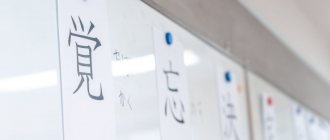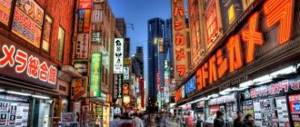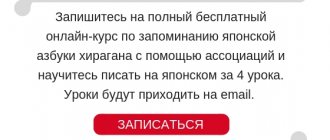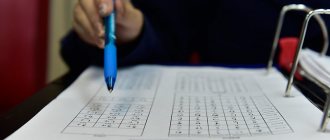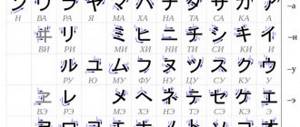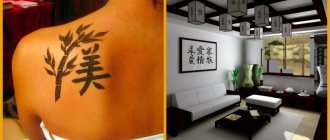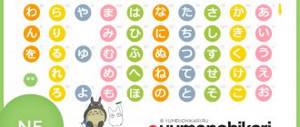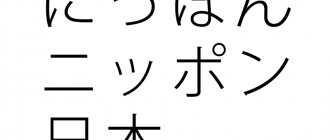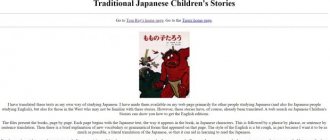Hiragana is the Japanese syllabary.
It is more correct to call its components not
Japanese letters, but symbols.
The fact is that almost all the characters of the Hiragana alphabet are syllables
, that is, a combination of a consonant and a vowel sound.
For example, in the Russian language there are separate consonant letters and sounds [s], [p], [r], [v], [n] and others. And also vowels: [and], [o], [a], etc. Most of the characters in the Japanese Hiragana alphabet are syllables. For example, な = [na], た = [ta], に = [ni], て = [te], せ = [se], etc. Japanese alphabet characters can also convey vowel sounds separately (see the first row of the table, for example)
To learn Japanese you need to start with the alphabet. Because understanding it opens the way to understanding the mysterious world of Japanese symbols, words, sentences, texts and other linguistic and cultural forms of the Land of the Rising Sun.
Therefore, if you are planning to learn Japanese on your own with us, then the first step you need to take is to learn the alphabet.
So, the sequence of your actions is as follows: 1)
You need to learn the basic alphabet symbols presented in the image.
How to learn them?
Our advice:
firstly,
use our tablet directly and,
secondly,
memory cards. The table has a transcription in Russian for each sign. And the cards only contain alphabet signs without pronunciation tips. Cards can be cut out and actively practiced with them. Write hints for yourself on the back and test yourself every day yourself, or you can ask someone in your household or friends to randomly show you cards, and you will name what kind of sign is depicted on it. Believe me, it is very effective! But don't try to remember all the signs at once. Read more about memorization techniques below.
2)
But before you start learning and
visually
memorizing signs, we strongly recommend that you write them down sequentially in the appropriate copybook or a separate notebook, paying great attention to the CORRECT spelling of each element, each line. Remember! By writing down signs, you remember them many times faster.
To correctly write each character of the Hiragana alphabet, it is important:
firstly,
to geometrically correctly position it in the cell, namely in the center;
secondly,
write all the lines that make up the sign exactly in the sequence as presented in the copybook or video.
Please note that
the き and さ characters
in writing are different
from their printed version!
thirdly,
if you study on your own, then look at the original sign every time, and constantly compare how YOU wrote it, and whether you have any mistakes. Important! Each of us has a different handwriting and writing style. Therefore, from the very beginning, write the characters as perfectly and exactly as in the original. The correctness and beauty of your writing depends on this. You can watch a video on Hiragana spelling.
3)
So, a quick summary.
What you will need
to master the First Lesson of the Japanese Language: a) ABC (in the image above or below) b) Flashcards c) A notebook where you will write the characters d) Information on how to
correctly pronounce
Hiragana characters (see below , after the image with Hiragana) e) Great desire to learn Japanese ^^ Once you have mastered and distinguished all 46 Hiragana characters, proceed to the next step.
Second step
will involve studying the Rules of Reading in Japanese. You can familiarize yourself with them by following the link to the corresponding lesson.
Further
Having learned to read and understand various combinations of signs,
you can move on
to studying grammar itself, the first topic of which will be the Simple Uncommon Sentence.
Japanese language lessons for beginners (section N5) on our website have a clear sequence: Lesson 1, Lesson 2, Lesson 3
, etc. So please follow it. In the intervals between the main (numbered) lessons, additional ones will appear. They will expand your knowledge by providing information about new words, hieroglyphs, expressions, etc.
How many letters are in the Japanese alphabet
Before answering the question “how many letters are in the Japanese alphabet?”, it is necessary to understand Japanese writing, which is three-syllable and consists of 3 elements:
- Hieroglyphs (kanji)
- Hiragana alphabet
- Katakana ABC
One of the largest Japanese dictionaries, Dai Kanwa Jiten (Japanese: 大漢和辞典), contains about 50,000 kanji. In modern Japanese, the general educational minimum of 2136 characters is used in everyday life. This list for daily use is called Joyo Kanji (常用漢字). This is what Japanese people learn in school and every foreigner who learns the language should know.
The Japanese alphabet, hiragana and katakana, are syllabic alphabet and contain, contrary to popular belief, not 50 or 51 characters, but 46. This error is associated with one of the names of the Japanese alphabet - Gojuon, which translated means “50 sounds”. Indeed, a very long time ago, at the time of the creation of alphabets, there were 50 of them, but over time, some signs fell out of use, including ゐ and ゑ.
Now the Japanese have 2 syllabic alphabet and hieroglyphs. How this happened is a rather complex historical process. At first, the Japanese did not have a written language at all, they borrowed hieroglyphs from the Chinese, so initially kanji was not a Japanese script, but a Chinese one. Then, the Japanese made 2 alphabets from the simplified writing of some characters - hiragana and katakana, the peculiarity of which is that they sound the same, but they are different in spelling and methods of application. The characters of both of these alphabets are called kana, so the Japanese writing system in Japanese is called kanji-kana-majiri-bun (
kanji kana majiri bun Japanese 漢字仮字交じり文) is a mixed script consisting of hieroglyphs and kana (hiragana and katakana).
Also, in Japan there is a Latin letter - romaji (Japanese: ローマ字), which is used to write Japanese words in Latin letters. For example, abbreviations of foreign names will be written exactly as romaji, as well as words such as CD, OL, Wi-fi and others. Sometimes the names of stations and streets are duplicated in Romaji, but this only happens in large cities.
How is this applied in practice?
The root or stem of a word is written with a hieroglyph. The modified part of the word, function words and particles are written in hiragana. In modern language, katakana is used primarily to write borrowed words (Anglicisms), since over the past 50 years there has been a huge increase in the number of Anglicisms in the Japanese language. Just like in Russian in recent years words such as manager, merchandiser, etc. have appeared. When you hear these words, sometimes you don’t understand the meaning, the same is with anglicisms in Japanese - the Japanese do not always understand certain anglicisms, nevertheless, all these words are written in katakana. Borrowing comes not only from English, but also from Western languages in general (French, German, Russian). The names of animals and plants are also written in katakana, because the kanji for some names of flora and fauna are complex and not everyone knows them. There are no spaces in the Japanese language either; it is for this reason that in order to separate some words from others, the names of plants and animals are written not in hieroglyphs, but in katakana. In order for it to stand out in the text, because katakana is more square, hiragana is more rounded, so naturally they differ in appearance from each other.
For example, we want to write “I drink coffee” in Japanese.
私はコーヒーを飲む ੦ (watashi wa kohii nomu iru)
私はコーヒーを飲む ੦
The root of the word 私 (watashi) is written in kanji, then the case marker は is written in hiragana, then the word coffee
コーヒー (kohii) is a borrowed word (from the word coffee), and therefore is written in katakana, then the accusative case (who? what?) を is written in hiragana, then the verb 飲む (nomu), for the root of the verb “drink” we again use the hieroglyph (飲) , and we will write the inflected part of the verb む in hiragana.
As you can see, both signs and canas coexist in one sentence. Also note that we put a round dot at the end of a Japanese sentence. Before we start learning the Japanese alphabet, a little history about the Japanese language.
The history of the origin of hieroglyphs in Japan
In Japan, the characters are called kanji Kanji - these are Han characters - (Han Dynasty), which originally originated in China. The Japanese borrowed the bulk of their symbols from China, but in small quantities you will also encounter the so-called Kokuji (国字), which translated means “signs of the native country.” They were invented by the Japanese themselves, observing all the principles of creating hieroglyphs, with exactly the same hieroglyphic elements, that is, in appearance they are in no way different from Chinese characters.
Kanji came to Japan in a very interesting way. They did not penetrate directly from China, but when Buddhism was spreading in the country, which began in the 5th century, with the arrival of the embassy of the Korean Principality of Kudara with valuable gifts, among which were sculptures of Buddhas and handwritten texts of Buddhist works (sutras). Since then, the Japanese have revered the Buddhist faith and began to use hieroglyphs.
The hieroglyphs themselves originated in China from pictograms, these are some simplified images. Then they became more rounded (see picture), and the modern form of the hieroglyph looks more square. The original pictogram system grew into a more complex system of ideograms, you will agree that it is difficult to convey the word “politics” or “philosophy” with one simple picture, so the Chinese began to resort to a more complex, improved sign system. The development and formation of hieroglyphs took place in China itself, and kanji came to Japan in an absolutely ready-made form.
And in Japan, a very interesting story happened with kanji. At first, the Japanese began to use only signs, but they quickly realized that hieroglyphs in the form that exists in China do not suit the Japanese language at all. This is due to the differences between the Chinese and Japanese language systems. For example, in Chinese the past tense can be expressed with just one suffix, while in Japanese there is a verb ending that changes, moreover, the Japanese have different levels of politeness. The same verb, for example, 読む (yomi) to read, in the polite form will be 読みます (yomi masu), in the negation of the past tense 読みませんでした (yomi masendesita).
Therefore, at some point, the Japanese began to write down the significant part of the word using kanji, and they wrote the variable part of the word with a hieroglyph, but used the second character as a phonetic, that is, some hieroglyphs began to be used not by meaning, but phonetically. The most famous literary work that was written in this way is called Manyoshu (Japanese: 万葉集) - a collection of poetry, its name translates as “a collection of myriad leaves.” And such a recording system, based on the name of this poetry collection, was called man'yogana. From those signs that were used as phonetics, the Hiragana alphabet developed.
An example is how the excretory particle は (wa) was first written with a hieroglyph, and how this symbol was later transformed into a hiragana sign.
Thus, the Japanese came to create the alphabet, but they did not completely abandon the hieroglyphs because they highly valued Chinese culture.
Katakana appeared thanks to Buddhist monks, who, while reading various sutras and mantras, sometimes forgot some hieroglyphs. When they encountered complex characters, they began to sign on top with an abbreviated version of those simple hieroglyphs that they were absolutely sure of reading.
Since the sutras were written in a formal script, kana has a more square appearance than hiragana. Both alphabets arose at approximately the same time, but they have completely different paths and reasons for their emergence. The Japanese alphabet has such a history.
Pronunciation of “long” vowels
When the Japanese feel that a certain syllable or vowel is being pronounced unforgivably long, that is, longer than its “classical” pronunciation, they mark this in katakana notation by placing a long horizontal line (like our dash) after the syllable or vowel. In fact, figuring out when a sound lasts long enough to mark it with a line is extremely difficult (I never succeed), so this moment is only important for reading the text. It is almost impossible to determine for yourself when to draw a line in a recording, since the ideas of Russians, British and Japanese about the longitude of sounds differ greatly. Here is a more or less obvious example, this time, for a change, in English.
Note:
An almost exact sign of a “long” sound is the doubling of the vowel. Almost certainly, instead of a double vowel in katakana writing, you should put a dash - a sign of longitude.
TOP 3 techniques on how to quickly learn hiragana and katakana
Many people don’t know how to quickly learn hiragana and katakana, so they spend quite a lot of time on it, although they can be mastered in just 5 days each. Studying them may seem difficult at first glance, but in fact you can very quickly learn to memorize them without difficulty. And now we will share with you the secrets of how to do this. Thanks to this, you will quickly learn the Japanese alphabet.
1 secret. Use associations.
When information that is new, wild and incomprehensible to you, but is associated with something similar, with what you already know, will be remembered quickly and effectively. See for yourself:
The very first letter that opens the alphabet is “A”, the association with it is “watermelon”, one letter A is watermelon
Second letter I - swing
In our free course on Hiragana, Sensei Olga Pervova compiled her own associations for each kana from Hiragana. take the course using this link:
2 secret. The order of the traits makes life easier.
In Japanese, stroke order must be observed, both when writing characters and when writing hiragana and katakana. All kanas have their own clear structure.
Knowing the order of strokes gives you speed of writing, and you don’t have to think every time which stroke to start with. The order of strokes greatly simplifies life and makes writing characters automatic; it takes you less time to remember and write kan and hieroglyphs.
Kans come from hieroglyphs, and they have the same writing principle, usually horizontal lines are written first, and then vertical ones. In general, the Japanese are people who like to organize everything, and you need to get used to this, although in this case the sequence of writing strokes came from the Chinese.
3 secret. Breaking down the complex into simple
When learning a language, you need to know kanji, grammar, learn new words, as well as listening and consolidate all this with exercises, but it will be effective to break it down into parts and devote 10-15 minutes to each block. If you have allocated 1 hour a day to study Japanese, then you should not spend the entire hour learning new words, it is not effective. Try to learn the same list of new words for 10-15 minutes for 6 days in a row: you open the list of words, and it is the same. On what day will you realize that these are no longer new words, but old ones? Most likely, by day 3-4 they will already become very familiar to you. And if one day a week you spend an hour learning a list of new words, and then simply forget about them, the effect will be much worse. An important principle: a little bit, but every day.
Examples of spelling words
Now that (if) you have memorized the spelling and pronunciation of all the characters, I will give some examples of writing simple words. Of course, there are some nuances that I haven’t explained, but I’ll do that later.
It's exactly the same with English words. Oh, by the way, if you are wondering why I wrote the syllables “ru” and “ra” in katakana, but translated them as “lu” and “la,” then read on. If you haven’t noticed this, then you should re-read the above text again and figure out the spelling of the syllables.
Japanese Hiragana alphabet - learn in 5 steps
The Hiragana alphabet (Japanese 平仮名) conveys vowel sounds, syllables and 1 consonant (n ん), is used to write function words, particles and suffixes, as well as for phonetic clues when reading hieroglyphs. Hiragana is used in informal correspondence instead of kanji in cases where the kanji is unknown to the writer. Japanese textbooks use a lot of hiragana and often students know hiragana better than katakana. This kana comes from the cursive writing of the hieroglyph, which is why it is so round and ornate.
A Complete Chart for Beginners Learning Hiragana Online
Consonant group "H-B-P"
= ha / ha = hi / hi = hu (fu) / hu - the Japanese do not distinguish between “hu” and “fu” = he / he = ho / ho
= ba / ba - sometimes used as “va” = bi / bi = bu / bu = be / be = bo / bo
= pa / pa = pi / pi = pu / pu = pe / pe = po / po
As you can see, the Japanese liked the letter “x” so much that they decided to form not one, but two “hard” sounds from it! ^_^ The sound “b” is marked with the usual dashes, and “p” - with a circle ( hannigori
).
Derivative syllabization
If there are derived vowels, then there must be some derived syllables where these vowels are used. If you think so, then you are absolutely right. The rules for their formation are very simple. Any basic syllable is taken - “consonant_with_sound_” and” “, after this syllable the reduced “ya”, “yu” or “e” is written. We get a new syllable - “consonant_with_derivative_sound”, i.e. when pronounced, the old “i” sound is discarded and a derivative vowel is pronounced instead. I will not give all possible syllables, but you should understand the principle itself. This is what it looks like:
Note:
sometimes the derived vowel is written in the same size as all other syllables. In this case, if it comes after a syllable ending with the sound “i” (the sound, not the katakana “i”!), then we are still dealing with a derived syllable. And if it comes after any other syllable except “consonant + and”, then it sounds on its own.
